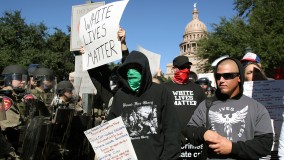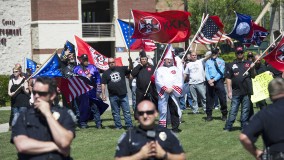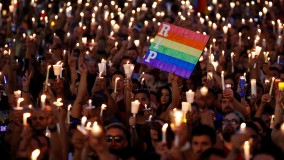
The starting point for understanding hate crimes and their impact is to recognize that criminal activity motivated by bias is different from other criminal conduct. First, these crimes occur because of the perpetrator’s bias or animus against the victim on the basis of actual or perceived status. The victim’s race, religion, ethnicity, gender, gender identity, sexual orientation, or disability is the reason for the crime. In the vast majority of these crimes, absent the victim’s personal characteristic, no crime would occur at all.
Second, because hate violence is intentionally, specifically targeted at individuals because of their personal, immutable characteristics they are very personal crimes, with very special emotional and psychological impacts on the victim – and the victim’s community. Hate crimes physically wound and may effectively intimidate other members of the victim’s community, leaving them feeling terrorized, isolated, vulnerable, and unprotected by the law. By making the victim’s community fearful, angry, and suspicious of other groups – and of the power structure that is supposed to protect them – these incidents can damage the fabric of our society and fragment communities.
It's impossible to address our nation’s hate crime problem without measuring it accurately. The FBI has been collecting hate crime data as part of its Uniform Crime Reporting (UCR) system since 1991 and provides the best national snapshot of the issue. As will be discussed below, however, this data is still clearly incomplete. In 2020, the FBI documented 8,263 hate crimes, reported by more than 15,000 law enforcement agencies across the country. However, according to national surveys conducted by the Department of Justice’s Bureau of Justice Statistics (BJS), almost 250,000 hate crimes occurred each year between 2005 and 2019. The BJS bases the estimate not on the UCR data collected from law enforcement agencies but rather on its annual National Crime Victimization Survey, which samples about 95,000 households. The actual number of hate crimes is likely somewhere between the BJS estimate and the number reported by the FBI.
As defined by the FBI, a hate crime is a violent or property crime – such as murder, arson, assault or vandalism – that is “motivated in whole or in part by an offender’s bias against a race, religion, disability, sexual orientation, ethnicity, gender, or gender identity.” In addition to the federal statutes, 46 states and the District of Columbia have hate crime laws. These laws differ in significant ways. All cover bias based on race, ethnicity, or religion, but many do not include gender, disability, sexual orientation, or gender identity. Arkansas, Indiana, South Carolina, and Wyoming do not have hate crime laws but still report hate crime data to the FBI
The FBI releases a hate crime report each year, but it vastly understates the extent of the problem for several reasons. First, hate crime reporting by law enforcement agencies (like the entire FBI crime reporting system) is voluntary. In 2020, 85% of the 15,136 agencies that reported data to the FBI reported zero hate crimes. Those agencies included about 60 cities with populations over 100,000. Another 2,500 jurisdictions, including 10 cities over 100,000, did not report any data. Second, according the BJS, in almost half of all hate crimes, victims never report the crime to police. Reporting is a two-way street: Officers must be trained to identify, report, and respond to hate crimes – and victims will only report if they trust the police and believe officials will respond effectively.

In its most recent report, the FBI reported 8,263 against persons, institutions, and property in 2020, compared to 7,314 reported in 2019, a 13% increase and the highest number reported since 2001.
Of the 8,263 hate crimes reported in 2020:

A group of “White Lives Matter” demonstrators protest near the state Capitol grounds in Austin, Texas. The demonstrators from Houston, numbering about 20, contended that the hate crime law is unfair to white people. (iStockPhoto)
Every year since 1991, the FBI has documented that racial bias has been the motivating factor in most hate crimes. But other factors involving the psychology of the offender have also been the subject of research. In one study widely used by law enforcement, sociologists Jack McDevitt and Jack Levin classified hate offenders as having four main motivations: thrill-seeking, defensive, retaliatory, and mission.

Members of the National Socialist Movement, a neo-Nazi group, rally for "white rights" on April 22, 2016, in Rome, Georgia. (AP Images)
Hateful speech – often intended to degrade, intimidate, or incite violence or discrimination against certain groups – is protected by the First Amendment and is not punishable under criminal law. However, the First Amendment does not protect violence, nor does it prevent the government from imposing criminal penalties for violent discriminatory conduct directed against victims on the basis of their personal characteristics. Americans are free to think, preach, and believe whatever they want. It is only when an individual commits a crime based on those biased beliefs and intentionally targets another for violence or vandalism that a hate crime statute can be triggered. Of course, racial, antisemitic, or anti-LGBTQ slurs – or other speech that vilifies a targeted group – can be evidence of a hate crime when used by someone during the commission of an underlying crime.

People take part in a candlelight memorial service the day after the June 12, 2016, mass shooting at the Pulse gay nightclub in Orlando, Florida. (REUTERS/Carlo Allegri)
Differentiating terrorist attacks from hate crimes is important to understanding motive, addressing the root causes of an offense, and prosecuting the offenders. Hate crimes are motivated at least in part by an offender’s personal bias and are disproportionately committed by nonpolitical youths, acting alone, not under the direction of an organized hate group, simply for the thrill of it. Terrorist attacks, on the other hand, are violent acts inspired primarily by extremist beliefs and intended as political or ideological statements. In some cases, perpetrators target individuals or institutions association with a specific identity – such as Jews or Muslims, as in a hate crime. In other cases, offenders target government installations or groups of civilians related more by proximity than by their individual identity.
Sometimes, a violent crime can be considered both a hate crime and a terrorist attack. An example is the 2015 massacre of nine Black people at a church in Charleston by a young white supremacist. For the most part, though, terrorist attacks are not included in tabulations of hate crimes.

Dr. Martin Luther King Jr. holds up photos of three young civil rights workers murdered during “Freedom Summer” in Mississippi in 1964. (Getty Images)
For much of American history, local law enforcement officials – especially in the Jim Crow South – simply refused to investigate or prosecute lynchings and other race-based crimes. Recognizing this fact, as part of the Civil Rights Act of 1968 Congress enacted 18 U.S.C. §245 (Violent Interference with Federally Protected Rights) to prosecute a number of white supremacists who committed murders, bombings, or other acts of violence to intimidate the Black community and civil rights activists. This law made it a federal crime to forcefully injure, intimidate, or interfere with someone – on the basis of their race, color, religion, or national origin – because of their attempt to participate in any of six federally protected activities, including voting or attending school.
In 1990, Congress passed the Hate Crime Statistics Act. It required the attorney general to publish an annual report on crimes that exhibit evidence of prejudice based on race, religion, sexual orientation, or ethnicity. The FBI was tasked with collecting and reporting this data under its UCR program, which has been gathering crime data from state and local law enforcement agencies on a voluntary basis since 1930.
Upon the passage of the Hate Crime Statistics Act, President George H.W. Bush referenced the Civil Rights Memorial, built and sponsored by the SPLC in Montgomery, Alabama. Bush quoted Martin Luther King Jr., whose words are etched on the memorial: “We will not be satisfied until justice rolls down like waters and righteousness like a mighty stream.” Bush added, “We must rid our communities of the poison we call prejudice, bias and discrimination. … The Hate Crime Statistics Act is an important further step toward the protection of all Americans’ civil rights.”
In 1994, the Violent Crime Control and Law Enforcement Act amended the Hate Crime Statistics Act to include bias against persons with disabilities.
The Church Arson Prevention Act of 1996 cemented the Hate Crime Statistics Act by making the collection of hate crime data a permanent part of the UCR program. Enacted after 66 Black churches were destroyed in less than two years, the Act additionally authorized the federal government to prosecute persons who burn or damage religious property.
In 2009, Congress passed the landmark Matthew Shepard and James Byrd Jr. Hate Crimes Prevention Act [Division E of the National Defense Authorization Act for FY 2010], named for two victims of horrific crimes based partly or wholly on their identities. Matthew Shepard, a 21-year-old gay student, was beaten and murdered in Wyoming. James Byrd Jr., a 49-year-old Black man, was dragged to his death behind a truck by three white supremacists in Texas.
The Shepard-Byrd Act changed federal hate crime law in several important ways. It removed the requirement that, to qualify as a hate crime, the victim must have been participating in a federally protected activity like voting. It expanded the existing hate crime law to include crimes motivated by a victim’s actual or perceived gender, sexual orientation, gender identity, or disability. It required the FBI to add gender and gender identity as categories of hate crimes it tracks. It gave the federal government greater flexibility to prosecute hate crimes that local authorities choose not to pursue. And it required the FBI to collect data concerning hate crimes committed by or targeting juveniles. The FBI began collecting this data in 2013.
In 2015, the FBI expanded the religious bias category and began collecting and reporting on hate crimes directed against Sikhs, Hindus, Arabs, Mormons, Jehovah’s Witnesses, and Eastern Orthodox persons.
The vast majority of hate crimes today are investigated and prosecuted by state and local law enforcement officials. Yet, as mentioned, four states do not have hate crime laws. In addition, only 30 states and D.C. cover sexual orientation; only 30 states and D.C. cover gender; only 16 states and D.C. cover gender identity/expression; and only 31 states and D.C. cover disability. The Shepard-Byrd Act serves as an essential backstop when state or local law enforcement officials either cannot or will not investigate and prosecute a hate crime.